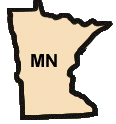South Dakota Edges Minnesota for Largest Population Growth Rate in Midwest
South Dakota ends a string of three consecutive decades in which Minnesota led the 12-state region in rate of growth

For a variety of reasons, new U.S. Census Bureau data released today finds South Dakota to be the fastest growing state in the Midwest over the past decade – ending a three decade run at the top by its neighbor to the east.
South Dakota’s population grew by 7.9 percent for the 10-year span ending April 1, 2010 – from 754,844 to 814,180.
Minnesota’s population, meanwhile, grew by 7.8 percent, from 4,919,479 to 5,303,925.
Although its rate of growth was nearly two points below the national average of 9.7 percent, Minnesota staved off the loss of a U.S. House seat for a fifth consecutive decade dating back to the 1970 Census.
The 12-state Midwest region as a whole, however, has shed 27 seats during the 50-year span since the 1960 Census, including six seats this cycle: two in Ohio and one each in Illinois, Iowa, Michigan, and Missouri.
The six-seat loss for the Midwest is tied for the third largest in history – behind the eight-seat drops after the 1980 (121 to 113 seats) and 1990 (113 to 105 seats) Censuses. Six seats were also lost regionally after the 1930 and 1940 Censuses.
South Dakota’s growth in 2010 ends a streak of three consecutive decades in which Minnesota had the fastest growing population in the Midwest.

Minnesota has been in the top half of Midwestern states for rate of population growth during each census period dating back to 1940.
South Dakota, meanwhile, had not ranked higher than sixth in population growth in the Midwest during any decade going all the way back to the 1920 Census.
However, the Mount Rushmore State’s growth rate regionwide has gradually improved – from 11th for the ten-year periods ending in 1960 and 1970, 9th in 1980, and 6th in 1990 and 2000.
The 2010 Census also marks the first time since 1910 that South Dakota has been ranked in the top half of the nation in the rate of population growth – coming in at #25 with Minnesota at #26.
South Dakota had been ranked #48, #41, #39, and tied for #35 nationally for population growth rate across each of the previous four census periods dating back to 1970.
The Mount Rushmore state also experienced negative growth after the 1970 (-2.2 percent) and 1940 (-7.2 percent) Censuses, ranking last in the nation for the latter.
Although Minnesota escaped losing a seat once again, the Gopher State will have to pay the piper sooner or later: Minnesota’s rate of population growth has been lower than the national average for each of the last seven decades.
Missouri had the third largest growth rate in the region at 7.0 percent, followed by Nebraska (6.7 percent), Indiana (6.6 percent), Kansas (6.1 percent), Wisconsin (6.0 percent), North Dakota (4.7 percent), Iowa (4.1 percent), Illinois (3.3 percent), Ohio (1.6 percent), and Michigan (-0.6 percent).
South Dakota and Minnesota Midwestern and National Population Growth Rate Rank by Census Period, 1910-2010
|
Census
|
SD Midwest
|
MN Midwest
|
SD National
|
MN National
|
|
1910
|
2
|
3
|
13
|
27
|
|
1920
|
7
|
3 (t)
|
36
|
20 (t)
|
|
1930
|
6
|
7
|
32
|
35
|
|
1940
|
12
|
1
|
50
|
21
|
|
1950
|
10
|
6
|
45
|
36
|
|
1960
|
11
|
6
|
43 (t)
|
24 (t)
|
|
1970
|
11
|
3
|
48
|
23 (t)
|
|
1980
|
9
|
1
|
41
|
33
|
|
1990
|
6
|
1
|
39
|
22
|
|
2000
|
6
|
1
|
35 (t)
|
21
|
|
2010
|
1
|
2
|
25
|
26
|
Note: Midwestern region states are Illinois, Indiana, Iowa, Kansas, Michigan, Minnesota, Missouri, Nebraska, North Dakota, Ohio, South Dakota, and Wisconsin. National rank includes the Alaskan and Hawaiian Territories prior to 1960. Table compiled by Smart Politics from U.S. Census Bureau data.
Follow Smart Politics on Twitter.
